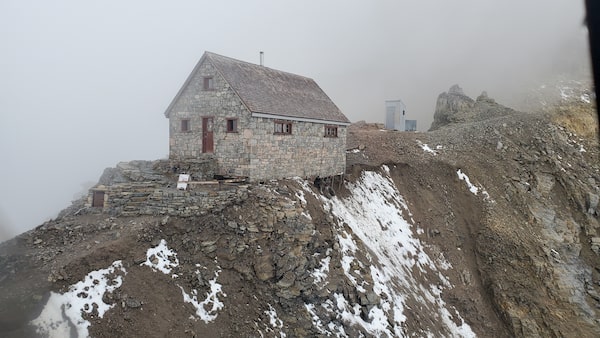
The Abbot Pass Refuge Cabin.Parks Canada
Climbers who’ve made the difficult but awe-inspiring hike to a century-old stone hut perched atop a mountain pass between British Columbia and Alberta are savouring their memories of the structure, which can’t be saved.
Parks Canada, steward of the Abbot Pass Refuge Cabin, made the tough decision to dismantle and substantially remove the structure, possibly this spring, after rockfall in 2016 led to its closure, spokesman Rick Kubian said.
Extensive geotechnical assessments made it clear that visitors’ safety could be at risk if the damaged national historic site remained accessible despite remedial work aimed at preserving it, said Mr. Kubian, a superintendent for the agency’s Lake Louise, Yoho and Kootenay field unit.
“You’ll see the rebar sticking out. That was supposed to anchor the hut onto the slope. But the erosion that occurred there made us come to the realization that the stabilization work we’d attempted was not going to be successful,” he said of the slope, which is no longer stable because of climate change.
“There’s bedrock in there somewhere, as well as a mix of rock and ice. It’s permafrost that’s been there for millennia, but it’s melting out and that rock and ice are collapsing.”
Further erosion in 2021 forced Parks Canada to expand an off-limits area to include Abbot Pass and two other routes.
Mr. Kubian said the agency will be consulting various groups, including about 10 First Nations in Banff, Alta., about how to best commemorate the building, which sits at an altitude of 2,925 metres.
“It’s quite disheartening,” he said. “It just so represents Canadian mountaineering in general. It’s just a super neat story, how the hut was built and how it’s been used over the years.”
Harvey Locke, a Banff conservationist whose grandfather helped build the hut in 1922, said he grew up hearing tales of the effort that went into making the “beautiful stone building” he first visited in the 1980s.
His grandfather, Ralph Harvey, ran a bus company in Lake Louise, Alta., and became friends with Swiss guides tasked with constructing the hut as part of a venture by the Canadian Pacific Railway, he said.
The guides, who lived in Golden, B.C., asked Mr. Harvey to organize horses that would carry supplies such as timber to a glacier before mountaineers took them to the pass, Mr. Locke said. The area was accessed through a potentially treacherous path called the death trap because of the possibility of avalanches, he added.
His grandfather’s stories have stayed with him, but the loss of the hut, which future generations won’t be able to enjoy because of climate change, now weighs heavily on him, Mr. Locke said.
“It’s a poignant example of the slow process of environmental misery we’ve inflicted on ourselves through the destruction of nature in the last century. And this is a sharp illustration of something that many people valued.”
The hut sits at the Continental Divide, prompting the running joke that if a raindrop split in two, half of it would go into the Pacific Ocean and the other would land in the Atlantic, Mr. Locke said.
It’s reachable from Lake O’Hara on the British Columbia side or via the more challenging route from Lake Louise.
Keith Haberl, spokesman for the Alpine Club of Canada, which has managed the two-storey hut since the 1980s, said it includes a kitchen, dining room and space for about 20 people who could stay overnight.
“It was definitely a feeling of reverence that you have for the work that was done to build it,” he said of the structure named after American mountaineer Philip Abbot. He is believed to have died from a fall in the area.
“Before Instagram, before it became really famous, it was known mostly just by mountaineers,” he said.
“It was a grand, grand piece of Canadian heritage, but it also operated as a modern hut.”
Our Morning Update and Evening Update newsletters are written by Globe editors, giving you a concise summary of the day’s most important headlines. Sign up today.